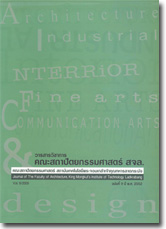ปัจจัยทางสถาปัตยกรรมที่มีผลต่อภาระการใช้พลังงานไฟฟ้าในบ้านเดี่ยว
Main Article Content
Abstract
บทคัดย่อ
การศึกษาปัจจัยทางสถาปัตยกรรมที่มีผลต่อภาระการใช้พลังงานไฟฟ้าในบ้านเดี่ยว เป็นการพิจารณาองค์ประกอบและปัจจัยที่เกี่ยวข้องกับการออกแบบสถาปัตยกรรมอันมีผลต่อการป้องกันความร้อนเข้าสู่อาคาร การลดความร้อนภายในอาคาร การระบายอากาศ และการใช้แสงธรรมชาติ ซึ่งส่งผลโดยตรงต่อภาระการใช้พลังงานไฟฟ้าในการปรับอากาศและให้แสงสว่าง เพื่อเสนอแนวทางการออกแบบและปรับปรุงอาคารเพื่อเพิ่มประสิทธิภาพการประหยัดพลังงานให้อาคาร ผู้วิจัยได้ศึกษาปัจจัยด้านสถาปัตยกรรมที่มีผลต่อภาระการใช้พลังงานไฟฟ้าของบ้านเดี่ยว โดยการค้นคว้าทฤษฎีและหลักการออกแบบที่เกี่ยวข้อง และพิจารณาปัจจัยและองค์ประกอบทางสถาปัตยกรรม ซึ่งแจกแจงปัจจัยต่างๆออกเป็นกลุ่มหัวข้อต่างๆตามเนื้อหา และพิจารณาตัวแปรที่สามารถควบคุมได้เพื่อเสนอแนวทางการออกแบบหรือปรับปรุงให้เกิดการประหยัดพลังงานไฟฟ้าในอาคาร โดยอ้างอิงหรือประยุกต์จากทฤษฎีและหลักเกณฑ์ด้านการออกแบบอาคารประหยัดพลังงาน ทฤษฎีด้านการใช้พลังงานไฟฟ้าอย่างมีประสิทธิภาพ และข้อกำหนดทางกฎหมายที่เกี่ยวข้อง ผลจากการศึกษาได้สรุปเนื้อหาครอบคลุมปัจจัยด้านสถาปัตยกรรม แบ่งออกเป็น 3 หัวข้อ คือ 1. สภาพแวดล้อมอาคาร 2. ลักษณะทางสถาปัตยกรรม และ 3. ระบบประกอบอาคารและอุปกรณ์ไฟฟ้าประกอบอาคาร ผู้วิจัยได้ศึกษาในประเด็นที่สำคัญ คือ การป้องกันความร้อนเข้าสู่อาคาร การลดความร้อนภายในอาคาร การระบายอากาศ และการใช้แสงธรรมชาติ เพื่อลดภาระการใช้พลังไฟฟ้าในการปรับอากาศและให้แสงสว่างเป็นหลัก ผลที่ได้จากศึกษาดังกล่าวทำให้ทราบถึงตัวแปรที่มีผลต่อภาระการใช้พลังงานไฟฟ้าในการปรับอากาศและให้แสงสว่างของอาคาร และเสนอแนวทางออกแบบปรับปรุงบ้านเดี่ยวให้มีประสิทธิภาพการประหยัดพลังงานไฟฟ้าตามทฤษฎีหรือเกณฑ์ใช้อ้างอิง สถาปนิกและบุคคลทั่วไปสามารถใช้แนวทางดังกล่าวปรับปรุงแนวทางการออกแบบรวมถึงพฤติกรรมการใช้พลังงานไฟฟ้าในอาคาร เพื่อให้ประหยัดพลังงานไฟฟ้าได้ดียิ่งขึ้น
คำสำคัญ : ปัจจัยทางการออกแบบสถาปัตยกรรม, ประหยัดพลังงานไฟฟ้า, บ้านเดี่ยว, บ้านประหยัดพลังงาน
Abstract
To study about architectural factors of electricity usage in detached houses is about to consider architectural design factors which protect the heat to the buildings, the decreasing of heat inside the building, ventilation, usage of sunlight which have direct affect to electricity usage in adjust the air and provide the light and to suggest the way to design and adjust the building to efficiently in saving the energy. Researchers have studied the architectural factors of electricity usage in detached houses by searching the theory and designing principle and consider the factors and composition of architectural for giving different factors to group the topic along as the content and consider the variable which can control the way or adjust the saving electric in the buildings by refer to the theory and faith rules in using electricity. The results from the study, we have concluded all the content about architectural which can divided into 3 topics 1. building environment 2. characteristic of architectural 3. the system to build the building and electricity attached to the building. Researchers have studied the important point is to protect the heat to the building, the decreasing the heat inside the building, ventilation, natural light usage, for reducing the usage of energy in adapt the air and giving the lightness. From the studying, make us known about the variable that have effect of the burden to the electricity usage in adjust the air and giving the light to the building and we also giving the way to improve detached houses for efficiently in electricity usage as the theory and rules that refer to. Architecture and also normal people can use the way that we say as above to adjust the way to design and also the way of behavior to using electricity in the house for reducing the electricity usage.
Key words : architectural design factors, electricity saving, detached houses, energy-saving houses
Article Details
This work is licensed under a Creative Commons Attribution-NonCommercial-ShareAlike 4.0 International License.
Copyright Transfer Statement
The copyright of this article is transferred to Journal of The Faculty of Architecture King Mongkut's Institute of Technology Ladkrabang with effect if and when the article is accepted for publication. The copyright transfer covers the exclusive right to reproduce and distribute the article, including reprints, translations, photographic reproductions, electronic form (offline, online) or any other reproductions of similar nature.
The author warrants that this contribution is original and that he/she has full power to make this grant. The author signs for and accepts responsibility for releasing this material on behalf of any and all co-authors.


